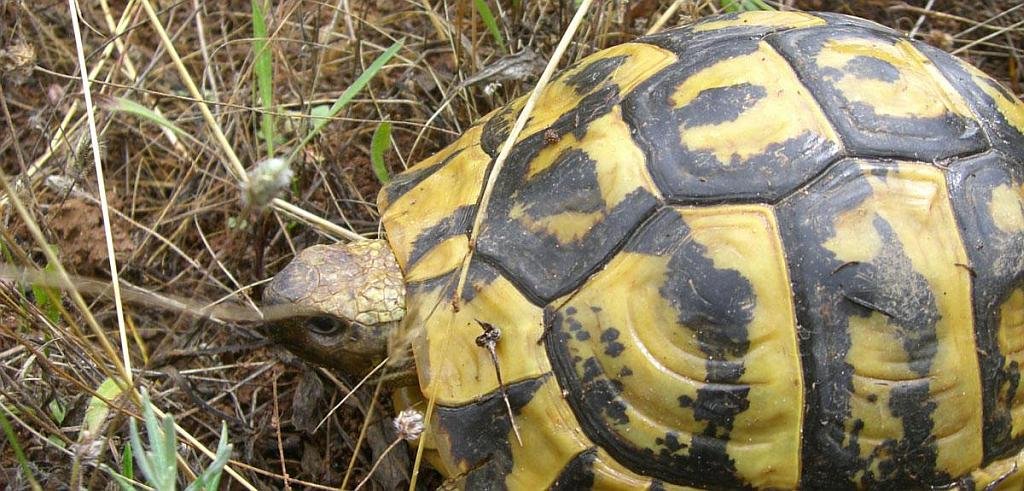- Region: Islas Baleares.
- Island / Town: Mallorca / Santanyí.
- Declared a Natural Park: 1992.
- Park surface area: 750 hectares.
Points of interest
With its formations of cliffs and vegetation of pine, scrub and traditional cultivation the Cala Mondragón Natural Park (in Mallorcan, Parc Natural de Mondragó) is one of the most visited Natural Parks on the island of Mallorca. (Perhaps due to the easily accseible beach which does bring into question the level of protection for the area). It is also a Natural Area of Special Interest (ISNA) and is part of the Natura 2000 network as a Special Protection Area (SPA). Most of the park is located on privately owned farmland apart from around 90 hectares owned by the state.
Birdlife is well represented in the area, with more than seventy species documented, many of them migratory. The park is a refuge for stone curlew (Burhinus oedicnemus), wood pigeon (Columba palumbus), turtle dove (Streptopelia turtur), kestrel (Falco tinnunculus), hoopoe (Upupa epops) and many other smaller birds including great tit (Parus major) and warblers (Sylvia sp).
With the exception of its beaches, the rocky cliff-lined coast is an ideal nesting ground for peregrine falcon (Falco peregrinus). Also found here is the European shag (Phalacrocorax aristotelis) and the Audouin’s gull (Larus audouinii).
Find a hotel close to the Cala Mondragón Natural Park in Mallorca
[booking_product_helper shortname=”cala mondragón natural park (mallorca)”]
Mammals present include hedgehog , weasel, stone marten, genet, field mouse, common dormouse, rabbit and hare.
Both the rocky landscapes and the many dry stone walls are favourite resting spots for certain reptile species, including the Moorish gecko (Tarentola mauritanica) and false smooth snake (Macroprotodon mauritanicus). In the “garrigue” The Hermann’s tortoise (Testudo hermanni) is present and some hundreds of specimens have been reintroduced in recent decades.
The park can be seperated into distinct areas
Garrigue
This is the dominant vegetation in the park. It is characterized by the presence of a variety of shrubs such as rosemary (Salvia rosmarinus), lavender (Lavandula dentata ), rock and sun roses (Cistus albidus, Cistus monspeliensis ) and heather (Erica multiflora ). Among the trees wild olive (Olea europaea var.sylvestris ) and juniper (Juniperus phoenicea ) are present.
Wetlands
Two brackish ponds are formed at the end of the S’Amarador streams and the fountain, Font de n’Alis. Inhabiting these pools are the common reed (Phragmites australis), the spiny rush (Juncus acutus) and the statice (Limonium sp.).
Occasionally found here are mallard (Anas platyrhynchos), common moorhens (Gallinula chloropus), common coots (Fulica atra), and herons (Egretta garzetta and Ardea cinerea). The ponds are also the home of the viperine snake (Natrix maura) and the Iberian marsh frog (Rana perezi).
The fish commonly seen here include the mullet (Mugil cephalus), the mosquito fish (Gambusia affinis) and eel (Anguilla anguilla).
Dune vegetation
On the beach of s’Amarador plantlife is made up of sea thistle (Eryngium maritimun), sea lily (Pancratium maritimum) and sand grass (Elymus farctus).
Rocky coast vegetation
On the rocky coast, vegetation is specific to its environment of extreme conditions such salt, strong winds, and the lack of soil. Look for sea fennel (Crithnum maritimum ), limonium (Limonium minutum), and the endemic Launaea cervicornis.
The orchid family is also well represented in the area. In the autumn look out for Spirantes spiralis and during winter sombre bee-orchid (Ophys fusca) and the giant orchid (Himantoglossum robertianum). During the spring see if you can find orchids such as the sawfly orchid(Ophrys tenthredinifera ), pyramidal orchid (Anacamptis pyramidalis) and the Balearic bee orchid (Ophrys balearica) which is endemic to the Balearic Islands.
Other day trips and activities in the area from Get your Guide
Information/Visitors Centers in the Cala Mondragón Natural Park
The Cala Mondragón Natural Park information centre and the shop are located near the Ses Fonts de n’Alis parking area.
At the time of writing parking in the area is not free and is managed by a local organisation.
Website: https://en.balearsnatura.com/parque_natural/parque-natural-de-mondrago/
The Grazalema Guide
The best way to see all our web projects in one place is over at the Grazalema Guide.
The Grazalema Guide – Tourist Information Portal for the Sierra de Grazalema, Wildside Holidays, The town of Ronda and the Caminito del Rey.
I’ve been living in this lovely area of Western Andalucia for the last 20 years or so and dedicate most of my time to the running of English language tourist information websites for the towns of Cádiz, Ronda, Grazalema, the famous or infamous Caminito del Rey, and also Wildside Holidays, which promotes sustainable and eco-friendly businesses running wildlife and walking holidays in Spain. My articles contain affiliate links that will help you reserve a hotel, bus, train or activity in the area. You don’t pay more, but by using them you do support this website. Thankyou!
